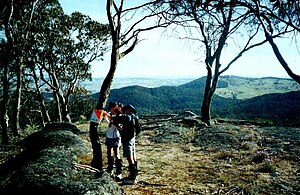Rogaining

Competitors at a checkpoint
|
|
| First played | Australia |
|---|---|
| Characteristics | |
| Team members | 2 - 5 |
| Mixed gender | Mixed |
| Type | Outdoor |
Rogaining is an orienteering sport of long distance cross-country navigation, involving both route planning and navigation between checkpoints using a variety of map types. In a rogaine, teams of 2–5 people choose which checkpoints to visit within a time limit with the intent of maximizing their score. Teamwork, endurance, competition and an appreciation for the natural environment are features of the sport. Championship rogaines are 24 hours long, but rogaines can be as short as three hours.
Rogaining can trace its roots back to 1947 when the first of many events with some of the features of rogaines was organized by the Melbourne University Mountaineering Club. The events from the 1940s eventually led to the birth of the sport of rogaining in April, 1976, in Melbourne, Australia. The sport was named, rules were adopted and the world’s first rogaining association was formed (the Victorian Rogaining Association). Growth of the association and the sport occurred rapidly over the next decade.
The word rogaining is derived from the names of three of the founders, Rod Phillips, Gail Davis (née Phillips) and Neil Phillips (RoGaiNe, hence 'rogaining', 'rogainer' etc.) who were all members of the Surrey-Thomas Rover Crew which organized the world's first rogaine. The name was formally adopted by the Victorian Rogaining Association at its inaugural annual general meeting in August, 1976 and accepted by Scouts Australia and University bushwalking groups to give the new sport an identity in its own right.
World Rogaining Championships were first held in 1992, and then every two years from 1996 to 2012. Since then they have been held annually, with the country chosen two years in advance by the International Rogaining Federation.
Teams of two to five members visit as many checkpoints as possible in the time allowed. Shorter duration rogaines often allow solo competitors. Checkpoints are scored differently depending on level of difficulty in reaching them; therefore teams choose a strategy (for example, to visit many low score checkpoints). Teams travel entirely on foot, navigating by map and compass between checkpoints in terrain that varies from open farmland to hilly forest. A central base camp known as a "hash house" provides hot meals throughout the event and teams may return at any time to eat, rest or sleep. Teams travel at their own pace and anyone from children to grandparents can experience the personal satisfaction that comes from cross-country navigation at their own level of competition and comfort. Team members stay within earshot of each other.
...
Wikipedia
